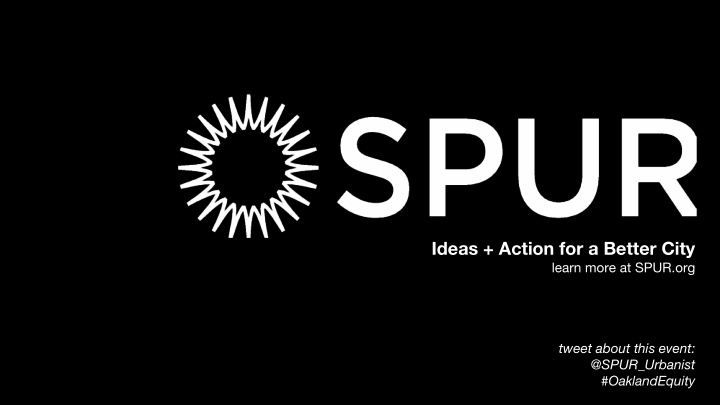



Ideas + Action for a Better City learn more at SPUR.org tweet about this event: @SPUR_Urbanist #OaklandEquity
MEASURING CHANGE TOWARD GREATER RACIAL EQUITY 2018 OAKLAND EQUITY INDICATORS REPORT
This report has been made possible thanks to funding from: Oakland community members and organizations AND SUPPORT FROM: The Department of Race and Equity Former Resiliency Officer Ethan Guy and Jeanette Wickelgren, Data Analyst
OVERVIEW
OVERVIEW
OVERVIEW
OVERVIEW
OVERVIEW
WHY EQUITY INDICATORS? “Not everything that is faced can be changed, but nothing can be changed until it is faced.” James Baldwin
REPORT STRUCTURE
RESULTS Overall Score: 33.5 Equity Indicators 2018 Report
Highest Scoring Indicators ¡ Equal Access Accommodations at 100 (within Neighborhood and Civic Life Theme: Civic Engagement T opic), ¡ Adopt a Drain at 80 (within Neighborhood and Civic Life: Civic Engagement), ¡ Homeownership with Mortgage at 78 (within Housing: Displacement), ¡ Life Expectancy at 77 (within Public Health: Mortality), ¡ and tied for fifth highest scoring were Labor Force Participation (within Economy: Employment) and Participation in Workforce Development Programs (within Economy: Job Quality), both at 72.
Lowest Scoring Indicators Education: Program Access – Suspensions ¡ Education: Teachers – Representation of Student Population ¡ Public Health: Child Health – Childhood Asthma Emergency Department Visits ¡ Public Health: Physical and Mental Health – Substance Abuse Emergency Department Visits ¡ Housing: Displacement - Homelessness ¡ Public Safety: Incarceration – Adult Felony Arrests ¡ Public Safety: Incarceration – Jail Incarceration ¡ Public Safety: Incarceration – Prison Incarceration ¡ Public Safety: Law Enforcement – Use of Force ¡ Public Safety: Community Stressors – Homicides ¡ Public Safety: Community Stressors – Juvenile Felony Arrests ¡ Neighborhood and Civic Life: Built Environment – Pedestrian Safety ¡
RACIAL EQUITY IS OUR RESPONSIBILITY “The arc of the moral universe may bend toward justice, but it does not bend on it’s own.” President Barack Obama
Working Assumptions • Race matters. Almost every indicator of well-being shows troubling disparities by race • Disparities are often created and maintained inadvertently through policies and practices that contain barriers to opportunity • It’s possible-- and only possible-- to close equity gaps by using strategies determined through an intentional focus on race • If opportunities in all key areas of well-being are equitable, then equitable results will follow • Given the right message, analysis, and tools, people will work toward racial equity Credit to the RACE MATTERS T oolkit, researched and funded by Annie E. Casey Foundation
SYSTEMS PRODUCE CERTAIN OUTCOMES AS A RESULT OF THEIR DESIGN
SYSTEMIC/INSTITUTIONAL RACISM A pattern of social institutions; such as governmental organizations, schools, banks, and courts of law, perpetuating negative treatment toward a group of people based on their race. Institutional racism leads to inequality in opportunity and inequity in life outcomes.
ADVANCING EQUITY = SYSTEMS CHANGE
Oakland
COMMON NARRATIVE ABOUT DISPARITIES Dominant Frame No Change ¡ Individualism - winners/losers “This narrative will always produce durable, persistent and racialized ¡ Personal merit or deficit poverty; built around just accepting People get what they deserve ¡ and tolerating this societal problem by framing it as an individual issue.” ¡ Backed with highly racialized ~ john a. powell assumptions
Transformation Equity Frame ADVANCING EQUITY REQUIRES NARRATIVE CHANGE “Liberty and Justice for all.” ¡ The individual develops in the context of access to opportunity ¡ Government has a role in addressing structural barriers ¡ Replace community marginalization with agency ¡ Community involved solutions necessary for transformation (Adapted from work by john a. powell & the Grassroots Policy Project )
High Opportunity Workshop
Low Opportunity Workshop LOW OPPORTUNITY WORKSHOP
PROGRAM DESIGN FOR EQUITABLE OUTCOMES Name the desired future condition – All residents of the City of Oakland are economically secure and living in thriving, healthy communities. Step 1 Use disparity data to understand current conditions – African American, Latinos and some Asian groups over represented in poverty, unemployment/underemployment, living with poor Step 2 health outcomes and shorter life expectancy. Work with the impacted community - to complete a root cause analysis to deepen understanding of the problem, and to determine what partnerships are needed to respond Step 3 comprehensively. Design equity approaches with rigorous performance measures – to address root Step 4 causes of disparities and to remove barriers to economic security. Repeat Steps 2 - 5 as needed – in a continuous improvement loop until desired future conditions from Step 1 are achieved. Step 5
EQUITY CULTURE CHANGE STRATEGIES ¡ Intentionally center a racial equity framework ¡ Build organizational capacity to make structural change ¡ Work with communities most impacted by disparities ¡ Use data; equity impact analysis to advise changes in policies ¡ Work with urgency; take strategic risks to advanced equity ¡ Track outcomes and measure progress – move the needle
YOUR NEXT STEPS HERE
Ideas + Action for a Better City learn more at SPUR.org tweet about this event: @SPUR_Urbanist #OaklandEquity
Recommend
More recommend